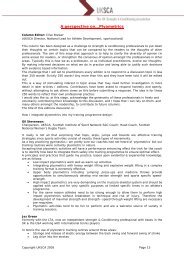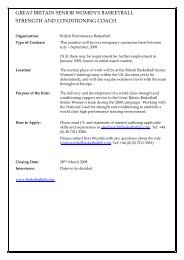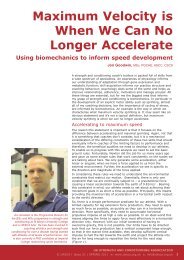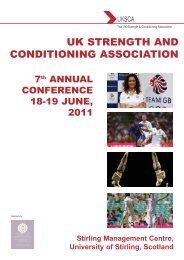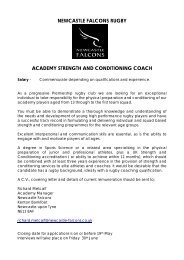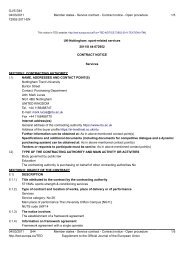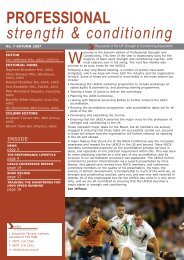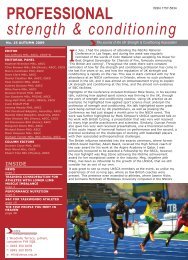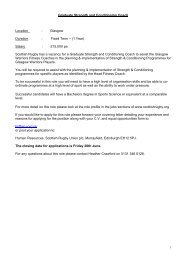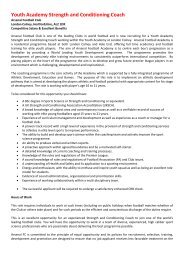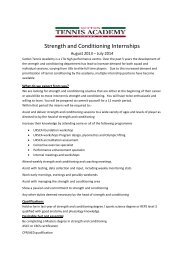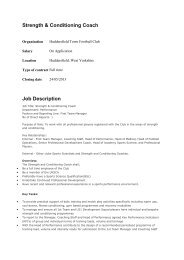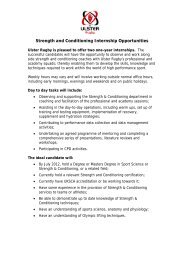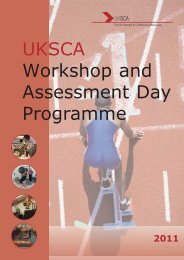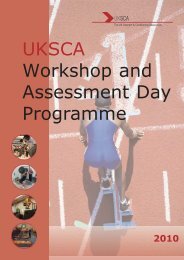uksca news june 2010.qxp
uksca news june 2010.qxp
uksca news june 2010.qxp
You also want an ePaper? Increase the reach of your titles
YUMPU automatically turns print PDFs into web optimized ePapers that Google loves.
PERFORMANCE NUTRITION<br />
Getting the “NAC” of<br />
antioxidant<br />
supplementation<br />
James Cobley BSc (Hons) and Graeme L Close PhD, ASCC, CSCS<br />
James Cobley graduated from Edge<br />
Hill University in 2009 with a 1st<br />
class degree in Sports Science. He is<br />
currently completing his masters<br />
degree in Sports Physiology at<br />
Liverpool John Moores University<br />
working alongside Dr Close<br />
investigating free radicals and cell<br />
signalling to determine the effects of<br />
N-acetylcysteine supplementation on<br />
recovery following repeated<br />
intermittent exercise.<br />
Graeme Close is the column editor for<br />
the ‘Performance Nutrition’ section.<br />
It is almost impossible to go through an entire day without being told<br />
by some advertisement that you must supplement your diet with some<br />
form of antioxidant, whether this be a breakfast cereal that has been<br />
fortified, a new fruit juice that has more antioxidants per glass than a<br />
traditional fruit juice, or even shampoo that has been enriched with<br />
antioxidants. We all seem to accept this premise without paying too<br />
much attention to exactly what antioxidants are and what they do –<br />
especially with respect to exercise. This article will review the current<br />
data regarding antioxidant supplementation in the sporting environment<br />
and produce general guidelines as to its optimal application.<br />
What is an antioxidant?<br />
Oxygen poses us a problem. On the one hand it is essential for life, on<br />
the other, it is a toxic mutagenic gas, resulting in the formation of<br />
potentially harmful reactive oxygen species (ROS). Historically, the first<br />
living organisms on earth survived under an atmosphere containing<br />
little oxygen and essentially were anaerobic. Rising atmospheric oxygen<br />
concentration, due to the evolution of photosynthetic organisms,<br />
resulted in many of these anaerobes becoming extinct. The few<br />
remaining anaerobes have adapted to the current oxygen concentration<br />
of 21%, by restricting themselves to environments where oxygen could<br />
not penetrate. Obviously, not all animals did this and a second line of<br />
defence was developed – this being the evolution of an antioxidant<br />
system to protect them against the toxicity of atmospheric oxygen.<br />
An antioxidant is any compound that prevents oxidation by molecular<br />
oxygen. Put simply, antioxidants neutralise ROS. Antioxidants can be<br />
divided into two classes: exogenous and endogenous. 21 Exogenous<br />
antioxidants such as Vitamin C (VC) and E (VE), are obtained through<br />
the diet, whereas endogenous antioxidants are naturally produced by<br />
the body. Notable endogenous antioxidants include glutathione (GSH),<br />
superoxide dismutase (SOD), catalase (CAT) and glutathione peroxidase<br />
(GPX). 19<br />
Does antioxidant supplementation improve<br />
performance?<br />
It is without doubt that uncontrolled ROS production can severely<br />
damage cellular lipids, proteins and DNA and are even associated with<br />
certain cancers. 19 Intense contractile activity accelerates ROS production<br />
to the extent that the cells antioxidant defences are transiently<br />
overwhelmed. The term “oxidative stress” is commonly used to describe<br />
this condition where there is a change in the “redox balance” (Figure<br />
1). However, it must be stressed that the true definition of oxidative<br />
stress involves the imbalance in oxidant/antioxidant ratio resulting in<br />
Graeme is a lecturer at Liverpool John Moores University in cellular and metabolic<br />
medicine. His current research is focused upon investigating cellular mechanisms<br />
responsible for muscle damage and repair. Graeme regularly presents at international<br />
conferences and has given keynote presentations on skeletal muscle damage and<br />
repair. Graeme is a former professional rugby league player and currently works with<br />
Munster RUFC as the performance nutritionist. He is also an accredited UKSCA<br />
member and a BASES accredited physiologist.<br />
UK STRENGTH AND CONDITIONING ASSOCIATION<br />
© UKSCA | Issue 18 | Summer 2010 w: www.<strong>uksca</strong>.org.uk e: info@<strong>uksca</strong>.org.uk 11



